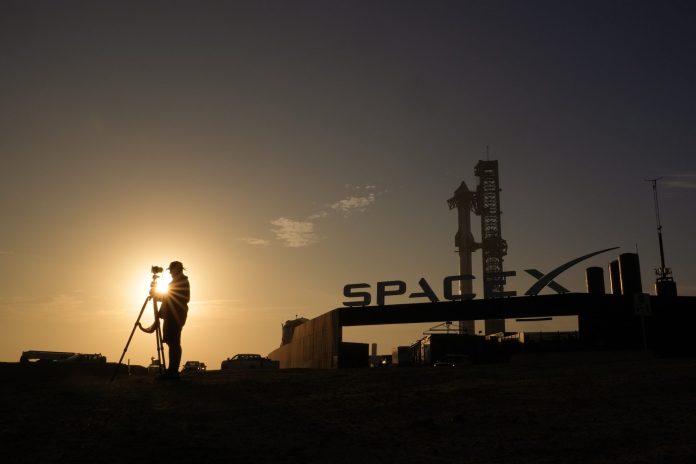
|
Only have a minute? Listen instead
Getting your Trinity Audio player ready...
|
SpaceX says it’s shooting for June 5 for the fourth orbital test flight of Starship, which will blast off from the company’s Boca Chica Starbase launch site.
The company also revealed on its website a number of details about what happened with the third orbital test flight on March 14, which ended with Starship S28 succumbing to extreme heat upon reentry rather than making a controlled landing in the Indian Ocean as planned.
Cameron County’s website shows “possible closure” notices for Boca Chica Beach and S.H. 4 near SpaceX. The primary date is June 5, with June 6-7 listed as backup dates. The hours of closure are 12 a.m. to 2 p.m. each day.
SpaceX conducted a successful “wet dress rehearsal” (WDR) of the stacked Starship S29 and Super Heavy B11 on the launch pad at Boca Chica on May 20. WDR entails filling the combined Starship S29 and Super Heavy booster B11 with more than 10 million pounds of liquid-oxygen and liquid-methane propellant and conducting a complete pre-launch countdown sequence.
As of Wednesday, Starship had been “de-stacked” and placed on the launch pad adjacent to the towering booster, still perched atop the launch mount, as SpaceX awaited permission from the Federal Aviation Administration for the fourth orbital flight.
As with previous test flights that did not go according to plan, SpaceX led the mishap investigation into the March 14 flight, with oversight from the FAA and participation of NASA and the National Transportation and Safety Board. The investigation found that the automated flight-termination systems aboard Starship and Super Heavy were not triggered, and that no debris from either vehicle fell outside pre-defined hazard areas, according to SpaceX.
“Pending FAA finding of no public safety impact, a license modification for the next flight can be issued without formal closure of the mishap investigation,” according to the company’s website.
SpaceX said the launch on March 14 began optimally, with all 33 of Super Heavy’s engines starting up and completing a “full-duration burn” during ascent, after which the two stages separated successfully and Starship’s six second-stage engines all started normally, powering the vehicle to its planned trajectory.
It was the first time a Starship has completed a full-duration ascent burn, SpaceX said.
Engine ignition issues foiled the booster’s planned soft landing in the Gulf of Mexico following stage separation, and contact with the vehicle was lost almost seven minutes after liftoff, with Super Heavy was approximately 1,500 feet over the Gulf, the company said. SpaceX said the ignition issues probably were caused by a blocked filter where liquid oxygen is supplied to the engines, though the next booster to fly (B11) has improved filtration capabilities and other upgrades to avoid a repeat of Flight 3.
Starship achieved several test-flight objectives following its ascent burn, during the vehicle’s “coast phase,” including testing the payload door in space for the first time, and completing a propellant transfer demonstration, moving liquid oxygen between propellant tanks.
“This test provided valuable data for eventual ship-to-ship propellant transfers that will enable missions like returning astronauts to the moon under NASA’s Artemis program,” SpaceX said.
The company has a $2.9 billion contract with NASA to develop Starship as the Human Landing System that will transport astronauts back to the moon for the first time since 1972 as part of the Artemis program.
SpaceX likewise detailed what happened to the second stage (Starship) on March 14, noting that the vehicle began losing attitude control several minutes into the coast phase, which in turn triggered a pre-planned command to skip a planned re-light of a single engine while in orbit. Starship did go through reentry from space, however, transmitting important data on frictional heating and vehicle control during hypersonic (more than five times the speed of sound) reentry, the company said.
“The lack of attitude control resulted in an off-nominal entry, with the ship seeing much larger than anticipated heating on both protected and unprotected areas,” SpaceX said.
The signal from Starship was lost about 49 minutes into the flight at an altitude of roughly 40 miles above the Earth, the company said, blaming clogged valves for the loss of “roll control.”
“SpaceX has since added additional roll-control thrusters on upcoming Starships to improve attitude control redundancy and upgraded hardware for improved resilience to blockage,” the company said.
These and other hardware and software upgrades have been incorporated into Starship S29, SpaceX said, adding that the focus now turns “from achieving orbit to demonstrating the ability to return and reuse Starship and Super Heavy.”
“We’re continuing to rapidly develop Starship, putting flight hardware in a flight environment to learn as quickly as possible as we build a fully reusable transportation system designed to carry crew and cargo to Earth orbit, the moon, Mars and beyond,” the company said.



